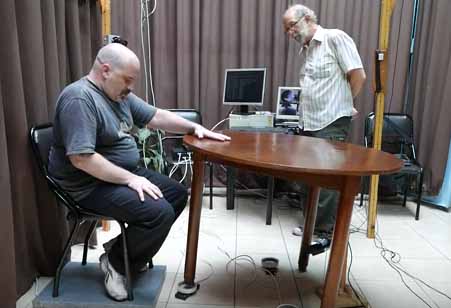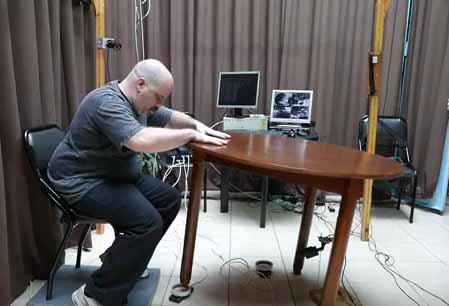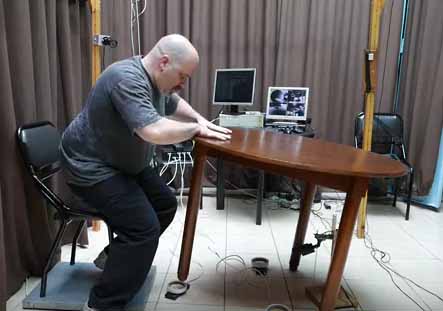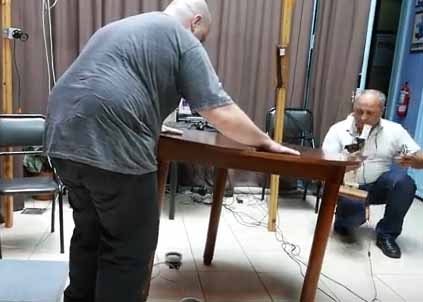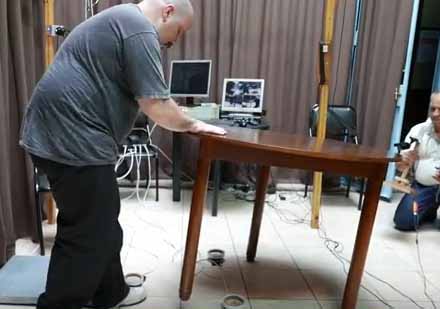This article describes successful psychokinesis experiments carried out in a laboratory in Buenos Aires betweeen 2013 and 2015. The subject was Ariel Farias, an Argentinian factory worker and martial arts teacher with no professional interests as a psychic.
Contents
Introduction
In April 2013, a nine-member PK sitter-group, called the Red Lights Group, was organized at the Institute of Paranormal Psychology (IPP) in Buenos Aires for the purpose of replicating the table movements often reported during the heyday of Spiritualism. Over the course of 15 meetings, investigators found that impressive movements of the table occurred only when one of the participants, Ariel Farias, was present. Thereafter, the study focused solely on Ariel, who under very careful scrutiny continued to raise (but not fully levitate) the table in normal illumination, always with hand contact. Formal work with Ariel began in August 2013 and continued through December 2015, documenting the table movements under conditions seeming clearly to rule out muscular effort as an explanation, and exploring further aspects of the phenomena. The history and results of the experiments are described in detail in two reports published in the Journal of Scientific Exploration.1Gimeno (2015); Gimeno & Burgo (2017).
Ariel’s History
Ariel was born in December 1975 in Buenos Aires. He is an intelligent and very likeable person, who completed his secondary education in public schools, is married with a young child, and (during the period of investigation) had a steady job at a textile factory. Although he is interested in parapsychology, Ariel is not a professional psychic and has expressed no interest in becoming one. His interest in psi research seems merely to be one aspect of an overall inquisitiveness that led him also to master the Chinese language and both study and teach martial arts. Stephen Braude, who conducted several tests with Ariel in December 2015, found him to be refreshingly unpretentious and cooperative—in sharp contrast to many other psychic claimants.2See the Appendix to Gimeno & Burgo (2017). Braude noted,
Ariel has no reservations at all about working under bright light and under close scrutiny, including close-up video monitoring from multiple angles. I’m very impressed by him personally, and it’s clear that Ariel is not driven by a desire to be a PK superstar or guru. I found him to be a down-to-earth and humble family man, reasonably content with a steady day-job, naturally curious about the PK abilities he has discovered (as well as psychic abilities generally), and with no religious or metaphysical axe to grind.3Gimeno & Burgo (2017), 183.
As with some other psychic subjects (for example, the so-called Gold Leaf Lady), Ariel’s psychic history began with poltergeist-type occurrences. When he was eleven years old, his father died suddenly, and Ariel was shocked, not only because of the loss, but because of a premonitory dream that accurately foreshadowed the details of his father’s death. Ariel subsequently became introverted, gained weight, developed nervous gastritis, and began also to have problems at school. At age 13, various anomalous disturbances started to occur at the flat Ariel shared with his mother. Those disturbances (detailed in Gimeno’s first report) continued for about one year.
Members of the Red Lights Group adopted a spiritist interpretation of the table phenomena they observed, but Ariel found this uncongenial. And although he seems to have come to terms with accepting his role as the cause of the table movements that have been recorded, he also dislikes being considered a rare individual. Throughout the several years in which he was studied, Ariel maintained a cheerful and inquiring attitude about the phenomena he produced, eager to discover how far he could develop his apparent ability, and hopeful that he could understand more about what he was doing.
Arranging for Formal Tests
Under the supervision of Alejandro Parra, Ariel’s principal investigators, Juan Gimeno and Darío Burgo, organized a laboratory in one of the IPP’s large rooms, and between June 2014 and December 2015 they held 23 meetings with Ariel. Three additional meetings were held without Ariel, to determine whether those present could duplicate the effects produced by Ariel (they could not).
In order to document table movements as clearly as possible, the investigators constructed a large wooden frame within which Ariel would sit, and from which they could strategically mount several video cameras. Additional video cameras were stationed on the floor to provide views of Ariel’s body and the underside of the table. Furthermore, Gimeno and Burgo modified five electronic scales, one of which was used to measure changes in Ariel’s weight, and the others of which measured changes in the table’s weight and the weight of other objects in the room. Gimeno and Burgo also devised a PC-based multivariable recorder with 16 independent channels. Data from the video cameras were fed to the recorder along with data from the scales and other sensors, including two for measuring temperature and one for measuring the rhythm of Ariel’s breathing.
Although Ariel experimented with several different tables, most of the time he used a specially constructed round, 3-legged wooden table weighing approximately 14 kg and with a diameter of 1.05 m. The ceramic tiles on the floor were smooth and rather slippery, and the investigators made sure that the table legs were not jammed into the grouted junctions between the tiles. In the three meetings held without Ariel, the investigators were able, by muscular force alone, to move the table horizontally, and they were also able to raise any table leg by pressing down on the side of the table opposite that leg. But they were never able to duplicate what Ariel did repeatedly—namely, raise the leg closest to and between the legs of the sitter (denoted as leg 1) without touching the table leg.
In his most successful sessions, Ariel needed five or six minutes of concentration before leg 1 would rise. But sometimes he required an hour or more before results occurred, and in some meetings (6 out of the 23), Ariel got no result at all. Gimeno and Burgo made the following observations concerning Ariel’s preparation for a test.
[Ariel] does not require any elaborate ritual to produce the phenomena. To feel more comfortable, he removes his ring, wrist chain, and watch. He can start working from a standing position or sitting in a chair, touching the table’s surface with the palms of one or two hands. He concentrates by keeping silent and closing his eyes from time to time. Once the table leg rises, he can start talking and laughing without any problem, and he can usually maintain that state of affairs for several minutes.4Gimeno & Burgo (2017), 167-68.
Interestingly, Ariel found it helpful to observe a digital readout from the electronic scale under leg 1, which showed how the weight decreased from approximately 4.8 kg to zero when the leg rose. Moreover, because that readout also indicated changes in the weight of the table leg even before that leg rose from the scale, Ariel could determine that his effort was on the right track.
Not surprisingly, Ariel found it difficult to maintain a high level of motivation, and a corresponding high level of success, over the series of experiments, especially since most experimental sessions followed roughly the same protocol. According to Gimeno and Burgo,
The only thing that seemed to reverse the decline in Ariel’s phenomena was the occasional visit from a ‘VIP’, or at least from certain of them. Ariel could clearly anticipate how the attitude of the visitor would influence his will and temper. We had requests from professional magicians, orthodox scientists, and professed skeptics (actually psi-deniers) certain from the start either that Ariel’s phenomena were fraudulent or that his investigators had committed some kind of error which they were determined to uncover. Previous encounters with members of that latter group had been unpleasant and inhibiting for Ariel. So further requests from that group were indefinitely delayed. On the other hand, when the visitor showed respect for and knowledge of the evidence for macro-PK and arrived with an open but critical mind, Ariel considered the situation to be a positive challenge. Indeed, these occasions often yielded some of his best results in terms of intensity and duration of the phenomena.5Gimeno & Burgo (2017), 168.
A high-definition video taken by Stephen Braude on 14 December 2015, shows Ariel raising leg 1. The clip shows one of the usual four security video cameras located above and to the left of Ariel, and another of the cameras under the table. The left computer screen shows the multivariable recorder data, and the right screen shows the four camera images taken and recorded by the DVR. In another video from that same session, Ariel can be seen raising leg 1 with only one hand lightly touching the near surface of the table.
In an earlier video, recorded on 2 December 2014, two cameras simultaneously capture the raising of the table leg, again with just one hand on the table. One of the views is panoramic, and the other provides a close-up view of Ariel’s hands and arms. The video shows clearly that Ariel made very minimal contact with the table, and only at the side nearest to him.
It is worth noting here that Ariel’s hands and forearms during these sessions were not sticky. Moreover, although Ariel reported feeling heat in his hands during successful trials, in fact his hands and forearms were rather cold to the touch. Gimeno and Burgo write:
…two temperature sensors of tiny mass were developed (one for each hand) and attached to the multivariable recorder. With an ambient temperature of 19.5 °C, the temperature of the hand palms became stabilized during the test at 32.7 °C for the left hand and 33.1 °C for the right (normal body temperature in Celsius varies between 36° and 37°). Thus, it appears that Ariel’s experience of intense heat in his hands is a purely subjective sensation.6Gimeno & Burgo (2017), 178.
Ariel also reported feeling as if he was, in a sense, merging with the table during his successful trials. Gimeno and Burgo note:
[Ariel] said that in the very moment the table began to move, he felt sensations similar to those felt by an airline passenger when the plane takes off. He also said that when the table leg rises, it’s ‘similar to when you put on your shoes; at the beginning you feel the difference between bare and covered skin, but in a few seconds you forget this difference and begin to feel the shoes as a part of you.’ He described the inverse sensation (removing one’s shoes) when the force disappears and the table leg falls down to the floor.7Gimeno & Burgo (2017), 178.
Furthermore, Ariel occasionally succeeded in lowering the weight of leg 1 (while watching the scale readout) while wearing cotton gloves or when paper was placed beneath his hands. And on at least one occasion, Ariel maintained the levitation of leg 1 after placing his hands atop that of Juan Gimeno, as can be seen here.
Further Results
Gimeno and Burgo found an unexpected and valuable use for the scale devised to measure changes in Ariel’s weight. They discovered that it could be used to distinguish between occasions when leg 1 was raised by muscular force and when it was raised by an unknown force (presumably PK).
During the sessions not attended by Ariel, the investigators found that they could raise table leg 1 through a combination of muscular force and friction of the hands against the table (especially when the hands were sweaty). This was accomplished only when the sitters’ arms were positioned horizontally toward the center of the table—that is, extended out much further than when Ariel touched the table. And on those occasions the weight of leg 1 dropped from approximately 4.5 kg to 2 kg. But the weight of the sitter as measured by the scale under his chair, also registered a decrease of 4 kg or more. Eventually, as the sitters applied more force to the table—and before the scale under leg 1 reached zero—the table would slip along the smooth ceramic floor.
By contrast, when Ariel positioned his hands on the near side of table, presumably without exerting muscular force, as the scale under le.g., 1 progressively reached zero, Ariel’s weight decreased only 2 kg, ‘equivalent values to the mass of Ariel’s body when he gently leaned forward…, while his hands and the table stayed immobile. These elements suggest strongly that leg 1 would not have been raised due to muscular force, but to an unknown force, presumably PK.’8IGimeno & Burgo (2017), 166.
During 14 of the experimental sessions, Gimeno and Burgo investigated whether Ariel’s efforts might influence the output of a random number generator. Readers interested in the full details should consult Gimeno & Burgo (2017). For present purposes, the following two graphs, taken from that paper, should suffice.
Figure 1 (graph 3): RNG values taken before Ariel Farías’s arrival. All values are clearly inside the chance area. Meeting 7 (09/02/2014), from 4:12 p.m. to 6:12 p.m.
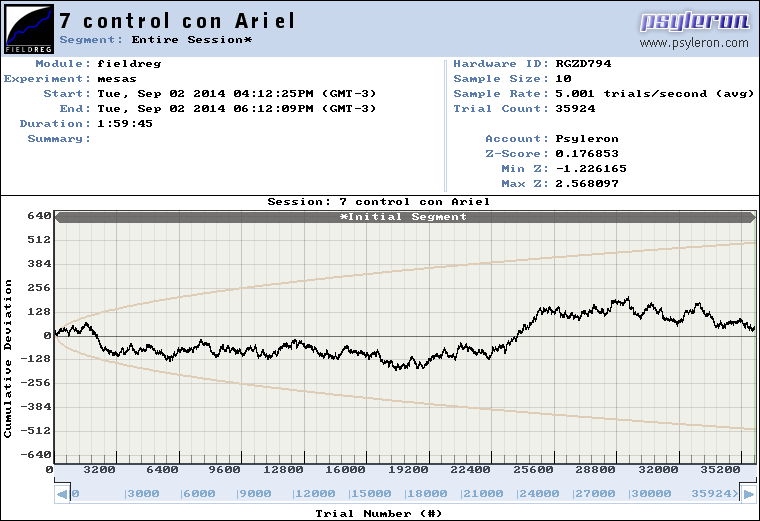
Figure 2 (graph 4): RNG values taken during Ariel Farías’s work trying to move the table. Values go in and out of the boundary line of chance. Meeting 7 (09/02/2014), from 6:13 p.m. to 7:11 p.m.
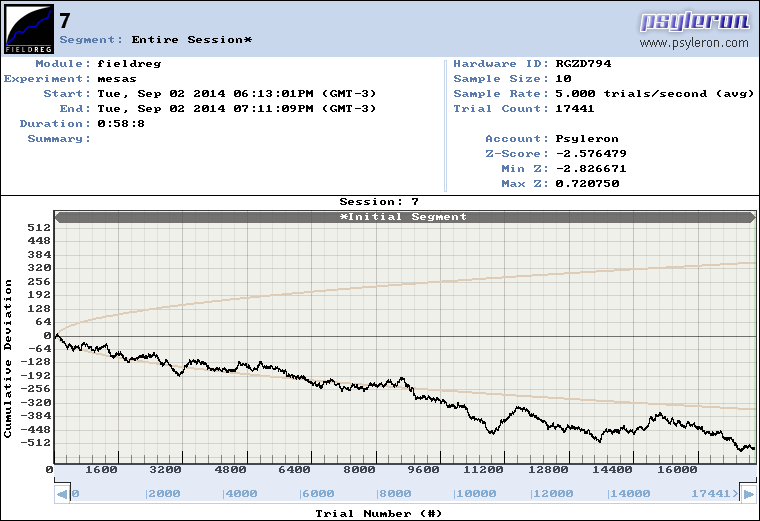
Gimeno and Burgo took EEG readings of Ariel on two occasions. The first, on 2 September 2014, examined Ariel ‘Ariel at rest, and subjected to sensorial excitation with light, sound, and touch, as well as during hyperventilation and recovery from it.’9Gimeno & Burgo (2017), 173. The second occasion, two weeks later, examined Ariel during a successful PK effort (one can view the video from this session at https://www.youtube.com/watch?v=KjfAmN-_9iI&feature=youtu.be.) According to Gimeno and Burgo, ‘The first study did not reveal any clinical abnormality’.10Gimeno & Burgo (2017), 173. But the ‘second EEG, during Ariel’s ostensible PK, detected anomalous curves and values that seem not to be explicable as ‘artefacts’.11Gimeno & Burgo (2017), 174. The following graph shows the relevant results.
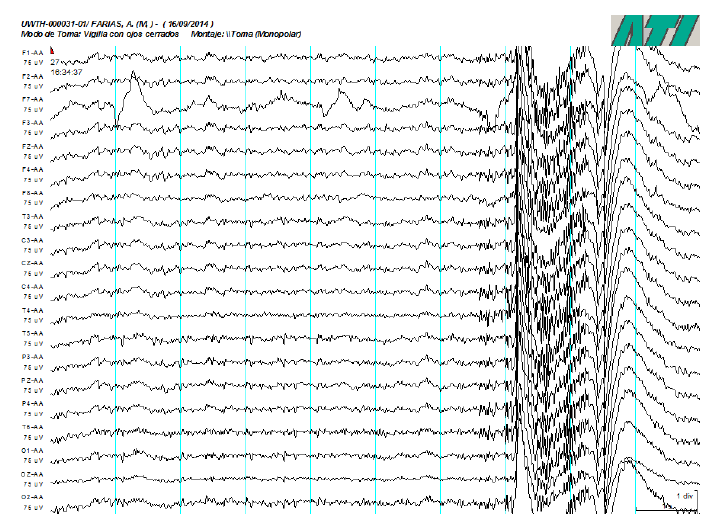
Figure 3: part of the EEG plot during apparent PK. Ariel was still, with eyes closed, hands on the table, and hyperventilating. A big electric perturbation is observed at the end of the plot, while the scale under the table leg indicated a weight reduction of 2.6 kg (the initial weight was 4.8 kg). The table leg rose nineteen seconds after the perturbation, by which time the EEG appeared to be normal.
Conclusion
Work with Ariel has not progressed since Gimeno and Burgo’s test series ended in December 2015: funding dried up and Ariel never managed to move beyond raising one leg (and very occasionally two legs) of the table. Of course Ariel’s lack of progress may also be due in part to the inevitable boredom resulting from repeating roughly the same procedures over and over. Nevertheless, Braude continues to search for funds to pursue other types of measurements of Ariel’s phenomena, and Ariel has indicated his willingness, in principle, to cooperate.
Stephen Braude
Literature
Gimeno, J. (2015). Shortage of rabbits or insufficient traps? Table-Turning and the discovery of a presumably PK-gifted person in Argentina. Journal of Scientific Exploration 29/4, 585-600.
Gimeno, J., & Burgo, D. (2017). Laboratory research on a presumably PK-gifted subject. Journal of Scientific Exploration 31/2, 159-86.

